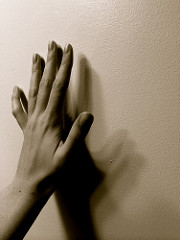
Photo CC-By sedona_tooley
I have decided to learn sign language. I am not really sure why I decided this. It was more of a ‘why not’ sort of decision, but nonetheless, here I am. I began this project excited and thought “how hard could this be?” We are all capable of doing anything but something we do not realize the difficulty ahead. After watching my first signing video I thought that I was getting the hang of this and couldn’t wait to learn more. During the week I discovered a site dedicated to learning sign language and it had numerous lessons to pick from. Of course I started at the beginning and found the first video I had watched. I discovered that this video was attached to an entire lesson plan. Each of these lessons had information on the signs learned and even had practice items, quizzes and tests. After going through all the information within the first lesson, I had already spent many hours learning the language. I decided I would go through one lesson each week. If some of the lessons are fairly shorter than the others then I will complete two lessons. Hopefully this will get me to where I hope to be by the end of the semester, which is being very familiar with the language. I had also decided to research a bit about the language. I was curious to how this language was developed and how the deaf community had adapted to using it. American Sign Language, or ASL, originated in the 19th century at the American School for the Deaf in Hartford, Connecticut. This school was also known as The American Asylum for the deaf and dumb, founded by Thomas Hopkins Gallaudet. Gallaudet inspired many others to come to his school and learn. They had also brought signs from their own homes before they had adopted his development of signing. From this, more deaf schools were founded and there was a rise in deaf community organizations. A survey from 1972 estimates a signing population between 250,000 and 500,00. There has not been a recent census of the signing population but I can only guess that this number had grown. Reading more about ASL, it became clearer to me that this is actually a language. I know that sounds funny, but when you first are introduced to signing, it doesn’t seem all that complicated. In actuality, it is as complicated as reading Swedish for the first time. One has to be very particular in their hand and finger movements. The slightest twist or movement across the face can have a completely different meaning. I wonder about the challenges I will face as I continue learning this language, but I will try my best and not give up.
Very cool! I think it would be neat if this was a 2nd language option in HS rather than standard, Spanish, French, German, etc. Maybe one day!
LikeLike
That is a great idea! I have heard that some cities have ASL teaching programs but no where around here. My school got rid of our french class and the only other option was spanish. I would love to see this happen. I mean why wouldn’t you want to be able to communicate with someone in complete silence?
LikeLike
This is interesting to know the history behind sign language. I don’t think I would have had the thought of “how hard can this be”, sign language seems hard!
LikeLike
It wasn’t that I didn’t think it would be hard. More like I didn’t think it would be THIS hard. It is still learning a new language.
LikeLike
This is an exciting topic and even if you don’t get to learning everything extensively it should give you the basics you would need to somewhat communicate.
LikeLike
I hope so!
LikeLike
Sign language would be really hard for me, so props to you, and also a lot of people are deaf and it would be cool to know how to communicate with them, you never know you could really like it!
LikeLike
I think I am learning to like it 🙂
LikeLike
This was really a great idea for your ILP. I hadn’t really thought about learning a new language (although some may say that learning “toddler” is a language) for the ILP. I’m excited to see how this goes for you. Good luck!
LikeLike
Thank you!
LikeLike